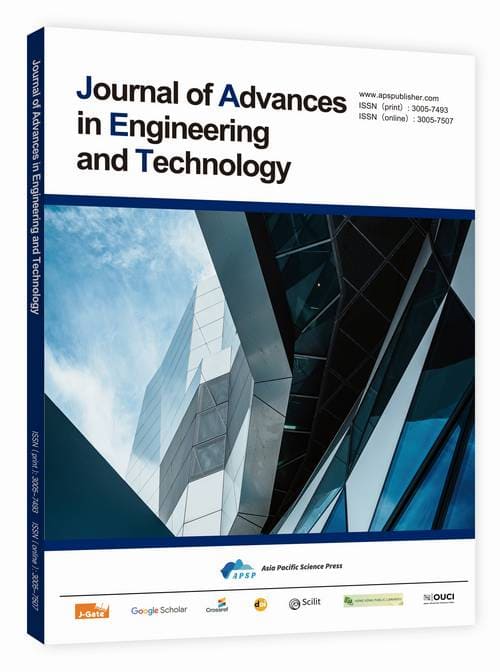A Review of Research on the Development and Application of Modular Steel Structures
DOI:
https://doi.org/10.62177/jaet.v2i4.844Keywords:
Modular Steel Structures, Connection Nodes, Intelligent Management and ControlAbstract
Modular steel structures combine the advantages of industrialized production and green construction, emerging as a key driver for the transformation of the construction industry. This paper focuses on summarizing existing research on inter-module connection technologies, primarily covering three aspects. It introduces the concept and characteristics of modular steel structures, analyzing their research and application status both domestically and internationally. This research emphasizes the current state of research on connection nodes between modules in modular steel structures, summarizing the technical features and existing issues of the two mainstream connection methods: bolted connections and plug-in connections. It analyzes the development trends and challenges facing modular steel structures in areas such as assembly devices, connection technologies, and intelligent management systems.
Downloads
References
Zhu, X., Yan, J., & Wu, J. (2022). Latest progress in connection nodes of modular steel structure buildings [in Chinese]. Building Structure, 52(S2), 1532–1538.
Wang, W., Li, Z., Yu, C., Liu, Y., Ye, H., & Li, Z. (2020). Research progress on structural systems of modular steel structure buildings [in Chinese]. Construction Technology, 49(11), 24–30, 36.
Hou, Z., & Liu, X. (2021). Key technologies and demonstration of industrialization of steel structure buildings [in Chinese]. Progress in Steel Building Structures, 23(10), 1–11.
Peng, L., Xie, H., Yuan, L., Hong, Y., Liu, H., Feng, X., Deng, B., & Xu, H. (2020). Application of prefabricated buildings in Wuhan Leishenshan Hospital [in Chinese]. Huazhong Architecture, 38(04), 71–77.
Yang, X., Lu, Y., Gu, C., & Liu, Q. (2016). Design of new multi-storey and high-rise steel structure box modular buildings [in Chinese]. Progress in Steel Building Structures, 18(05), 41–47, 72.
Ding, Y., Deng, E., Zong, L., Dai, X., Li, Y., Wang, H., & Bi, J. (2019). Research progress on connection nodes of modular steel structure buildings [in Chinese]. Journal of Building Structures, 40(03), 33–40.
Huang, X., Shu, Z., & Li, Z. (2022). Research progress on prefabricated modular buildings and modular nodes [in Chinese]. Progress in Steel Building Structures, 24(02), 40–49.
Hou, Z., Gong, C., Chen, J., et al. (2023). Industrialization technology and demonstration of fully prefabricated modular steel structure building system [in Chinese]. Progress in Steel Building Structures, 25(1), 1–10.
Liu, X., Ren, X., Zhan, X., & Zhang, Y. (2018). Mechanical performance analysis of beam–column joints of a box-type modular prefabricated steel structure house [in Chinese]. Industrial Construction, 48(05), 62–69.
Wang, Y. (2020a). Study on mechanical properties of new bolt-in-column joints in modular buildings (Master’s thesis, China University of Mining and Technology) [in Chinese].
Wang, Q., Su, M., & Qi, H. (2020b). Research on bending performance of cross plate–end plate modular steel structure connection nodes [in Chinese]. Construction Technology, 49(05), 44–48.
Pan, C., Wu, X., Zhou, L., & Wei, H. (2023). Application of BIM technology in design and construction of prefabricated steel structure buildings [in Chinese]. Information of China Construction, (05), 62–65.
Li, W. (2019). Research on development and construction technology of new composite wall panels for prefabricated steel structure buildings (Master’s thesis, Shandong Jianzhu University) [in Chinese].
Wen, X., Li, C., Chen, Y., Zhou, Y., Liao, X., & Zhang, X. (2021). Key technologies of integrated construction for modular steel structure buildings [in Chinese]. Construction Technology (Chinese & English), 50(18), 65–70.
Zhai, S., Cao, K., Li, G., Wang, W., Chen, C., & Liu, Q. (2022). Research progress on inter-module connection nodes of column-supported modular steel structure buildings [in Chinese]. Progress in Steel Building Structures, 24(11), 1–11.
Ye, J., & Yu, H. (2019). Research progress on connection nodes of steel structure modular buildings [in Chinese]. Guangdong Architecture Civil Engineering, 26(03), 9–12, 36.
Zhang, H., He, Y., Lu, H., et al. (2025). An evolutionary optimization method for modular structures made of predefined building blocks. Engineering Structures, 343, 121147. https://doi.org/10.1016/j.engstruct.2025.121147
Sharafi, P., Atashfaraz, B., & Kildashti, K. (2025). Novel rocking interconnection for superior prefabricated prefinished modular building system. Engineering Structures, 343, 120934. https://doi.org/10.1016/j.engstruct.2025.120934
Jin, J. Y., Qian, K., & Dong, Y. G. (2013). The application of energy efficiency system with EPS module steel structure of industrial building in construction engineering. Advanced Materials Research, 671–674, 2145–2149. https://doi.org/10.4028/www.scientific.net/AMR.671-674.2145
Xiong, F., Zhang, D., Ran, M., et al. (2025). Seismic performance of bolt-connected fully assembled concrete modular construction by full-scale shaking table test. Engineering Structures, 343, 121026. https://doi.org/10.1016/j.engstruct.2025.121026
Ly, H. D., Nguyen, N. H. D. T., Jang, H., et al. (2025). Developing a life cycle assessment-based framework for module-based impact distribution in adaptive reuse of modular buildings. Journal of Building Engineering, 112, 113703. https://doi.org/10.1016/j.jobe.2025.113703
Liu, Z. Y. (2025). Analysis on application effect of high-strength bolted connections in complex steel structure joints [in Chinese]. China Construction Metal Structure, 24(16), 88–90. https://doi.org/10.20080/j.cnki.ISSN1671-3362.2025.16.030
Chen, Z. X., Li, X. L., & Chen, W. (2024). Analysis of friction surface treatment methods for high-strength bolted connections based on tribological principles [in Chinese]. Total Corrosion Control, 38(12), 25–27. https://doi.org/10.13726/j.cnki.11-2706/tq.2024.12.025.03
Chen, Y. Y., Shen, Z. Y., Han, L., et al. (2004). Determination of slip resistance coefficient of joint surfaces coated with alkyd iron oxide red or polyurethane zinc-rich paint [in Chinese]. Building Structure, (05), 3–6. https://doi.org/10.19701/j.jzjg.2004.05.001
Liu, G., Li, Q. C., & Hu, A. J. (2009). Experimental study on the performance of high-strength bolted connections with sandblasted contact surfaces [in Chinese]. Journal of Suzhou University of Science and Technology (Engineering and Technology Edition), 22(03), 38–41.
Wang, Q. M., Hou, Z. X., Dong, X. H., et al. (2005). Experimental study on the performance of high-strength bolted connections with coated friction surfaces [Conference paper, in Chinese]. In Proceedings of the 5th National Symposium on Modern Structural Engineering (pp. 1181–1187). Tianjin University.
Chen, X. S., Shi, G., & Chen, Y. F. (2021). Experimental study on slip resistance coefficient of arc thermal sprayed aluminum contact surfaces for high-strength steel bolted connections [in Chinese]. Building Structure, 51(13), 87–92. https://doi.org/10.19701/j.jzjg.2021.13.013
Liu, X. (2020). Study on the ecology of new temporary buildings in the whole life cycle (Master’s thesis, Hunan University) [in Chinese]. https://doi.org/10.27135/d.cnki.ghudu.2020.001507
Song, L. L., Yan, W. M., Zhang, X. M., et al. (2020). Applicability analysis of self-piercing riveted connections in prefabricated light steel structures [in Chinese]. Journal of Beijing University of Technology, 46(01), 33–41.
Xu, L. H., Yang, X. L., & Zhang, G. (2024). Study on mechanical performance of new insert-type connection joints for modular steel structures [in Chinese]. Engineering Mechanics, 41(01), 30–38.
Dai, X. M. (2021). Study on seismic performance and design method of insert-type self-locking joints for modular steel structures (Doctoral dissertation, Tianjin University) [in Chinese].
Wang, X. M. (2023). Study on mechanical performance of new inner insert self-locking modular steel structure joints (Master’s thesis, China University of Mining and Technology) [in Chinese].
Ministry of Housing and Urban-Rural Development of the People’s Republic of China. (2018). Standard for design of steel structures: GB 50017—2017 [in Chinese]. Beijing: China Architecture & Building Press.
Wang, Y. Q., Wu, M. Z., Wang, Z. X., et al. (2025). Research on application technology of stainless steel grooved rivets and their connection joints [Conference paper, in Chinese]. In Proceedings of the 34th National Conference on Structural Engineering (Vol. I) (pp. 13–28). https://doi.org/10.26914/c.cnkihy.2025.040908
Wang, Q. H., Wang, X. J., Fang, J. J., et al. (2022). Preparation and performance study of water-based intumescent fire-retardant coatings for steel structures [in Chinese]. Paint & Coatings Industry, 52(02), 42–48.
Kong, S. (2013). Study on thermal insulation ceramic fibers based on animal fiber (silk) templates (Doctoral dissertation, Nanjing University of Science and Technology) [in Chinese].
Liu, D. C. (2012). Exploration on the frontier of ceramic fiber technology [in Chinese]. Advanced Ceramics, 33(01), 25–31. https://doi.org/10.16253/j.cnki.37-1226/tq.2012.01.004
Yao, S. Y. (2006). Study on the preparation process of mullite continuous fibers (Doctoral dissertation, China Academy of Machinery Science and Technology) [in Chinese].
Li, C. Z., Zhong, R. Y., Xue, F., Xu, G., Chen, K., & Huang, G. Q. (2017). Integrating RFID and BIM technologies for mitigating risks and improving schedule performance of prefabricated house construction. Journal of Cleaner Production, 165, 1048–1062.
McKinsey & Company. (2019). Modular construction: From projects to products. McKinsey Global Institute.
Chong, H. Y., Lopez, R., Wang, J., & Kim, C. (2016). Improving prefabricated construction productivity through BIM-based automated design validation. Automation in Construction, 72, 15–27.
Lu, W., Xue, F., & Zhao, R. (2021a). Digital twin-enabled smart construction: Conceptual framework, applications and future development. Automation in Construction, 123, 103558.
Wang, J., Li, H., & Tam, V. W. (2019). Critical factors in effective modular construction project management. Automation in Construction, 100, 1–11.
Zhao, X., Hwang, B. G., & Gao, Y. (2019). A critical review of building information modeling (BIM) for modular construction. Automation in Construction, 102, 120–131.
Tang, P., Huber, D., Akinci, B., Lipman, R., & Lytle, A. (2010). Automatic reconstruction of as-built building information models from laser-scanned point clouds: A review of related techniques. Automation in Construction, 19(7), 829–843.
Lu, W., Xue, F., & Zhao, R. (2021b). Digital twin-enabled smart construction: Conceptual framework, applications and future development. Automation in Construction, 123, 103558.
Gorgolewski, M. (2008). Design for deconstruction and materials reuse. Proceedings of the ICE – Waste and Resource Management, 161(4), 163–167.
Ding, T., Xiao, J., & Tam, V. W. (2016). A closed-loop life cycle assessment of recycled aggregate concrete utilization in China. Waste Management, 56, 367–375.
Li, X., Chi, H. L., & Wu, P. (2020). Sustainable design and construction of prefabricated buildings: A review of BIM and modular construction research. Journal of Cleaner Production, 273, 123013.
Zhao, X., Hwang, B. G., & Low, S. P. (2018). Critical success factors for enterprise risk management in modular construction projects: A sustainability perspective. Automation in Construction, 94, 146–158.
Farrar, C. R., & Worden, K. (2013). Structural health monitoring: A machine learning perspective. Wiley.
Zhang, Y., Zhu, L., & Wu, D. (2021). Acoustic emission-based bolt looseness detection using deep learning and time–frequency features. Mechanical Systems and Signal Processing, 158, 107756.
Teng, S., Li, J., & Xu, B. (2022). CNN-based vibration signal analysis for damage identification in steel structures. Engineering Structures, 252, 113615.
Sun, Z., Wang, W., & Chen, G. (2022). Vision-based bolt looseness detection using deep convolutional networks under varying illumination conditions. Automation in Construction, 140, 104378.
Downloads
How to Cite
Issue
Section
License
Copyright (c) 2025 Chunyang Hu, Siqi Li, Yibing Wang, Zijing Song, Chunhao Wang

This work is licensed under a Creative Commons Attribution-NonCommercial 4.0 International License.















